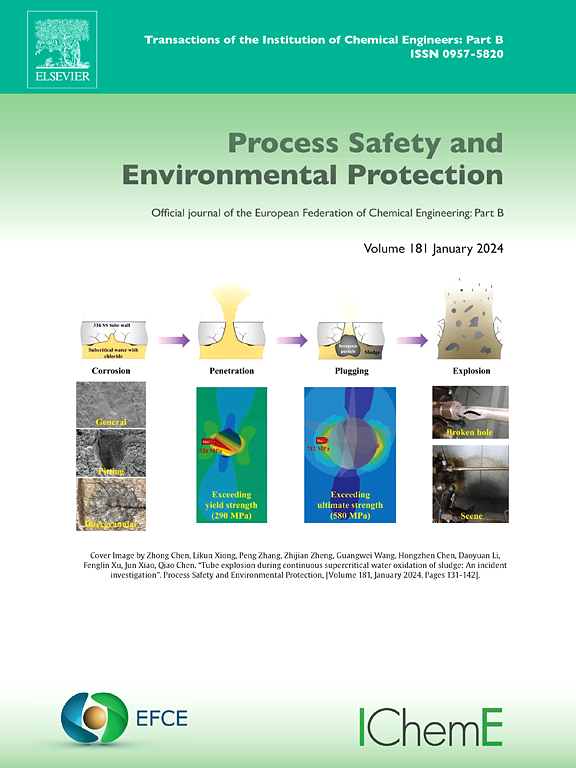利用哈茨木霉BPGF1修复六价铬和生产纤维素水解酶的集成生物工艺的开发
IF 7.8
2区 环境科学与生态学
Q1 ENGINEERING, CHEMICAL
引用次数: 0
摘要
本研究建立了一种独特的整合生物工艺,利用哈茨木霉BPGF1作为有前途的候选真菌,同时实现两个工业上重要的目标,六价铬Cr(VI)的去除和纤维素水解酶的协同生产。该分离物对浓度高达400mg/L的Cr(VI)具有较高的耐受性。然而,增加Cr(VI)水平导致真菌生物量减少和表面官能团可用性降低,导致去除效率下降。在亚致死浓度为50mg/L Cr(VI)时,纤维素酶和木聚糖酶活性均较对照显著增强,表明可能存在金属诱导的刺激作用。虽然许多研究都集中在单独优化铬去除或酶生产上,但还没有研究在单个系统中同时优化这两个过程。目前的研究采用多目标优化(MOO)来优化一组条件,使两种结果都最大化。通过多目标优化方法确定了最佳操作条件,Cr(VI)去除率为93.56 ± 3.12% (100mg/L),纤维素酶和木聚糖酶的产率分别为5.62 ± 0.75 IU/mL和470 ± 5.42 IU/mL。扫描电镜分析显示,与对照相比,菌丝相对不规则、聚集和肿胀,这被认为是一种解毒机制。EDX和FTIR分析证实了铬在真菌菌丝体上的吸附。本研究提出了一种生态高效、低成本的生物工艺,解决了环境解毒和酶协同生产问题,为工业废水处理和循环生物经济应用提供了实际意义。本文章由计算机程序翻译,如有差异,请以英文原文为准。
Development of an integrated bioprocess using Trichoderma harzianum BPGF1 for hexavalent chromium remediation and cellulolytic enzyme production
This study establishes a unique integrated bioprocess of using Trichoderma harzianum BPGF1 as a promising fungal candidate to concurrently accomplish two industrially significant goals, hexavalent chromium Cr(VI) removal and the co-production of cellulolytic enzymes. The isolate exhibited high tolerance to Cr(VI) concentrations up to 400 mg/L. However, increasing Cr(VI) levels led to a decline in removal efficiency, attributed to reduced fungal biomass and diminished availability of surface functional groups. Notably, at a sub-lethal concentration of 50 mg/L Cr(VI), both cellulase and xylanase activities were significantly enhanced relative to the control, indicating a potential metal-induced stimulatory effect. While many studies have been focused on optimizing either chromium removal or enzyme production individually, no research has yet simultaneously optimized both processes in a single system. The current study employed multi-objective optimization (MOO) to optimize a single set of conditions that maximizes both outcomes. A multi-objective optimization approach identified an optimal operational condition achieving 93.56 ± 3.12 % Cr(VI) removal (from 100 mg/L), along with cellulase and xylanase yields of 5.62 ± 0.75 IU/mL and 470 ± 5.42 IU/mL, respectively. SEM analysis showed relatively irregular, aggregated, and swollen hyphae compared to the control, which was adapted as a detoxification mechanism. EDX and FTIR analysis confirmed chromium adsorption onto the fungal mycelium. This study presents an eco-efficient, low-cost bioprocess that addresses environmental detoxification and enzyme co-production, offering practical relevance for industrial wastewater treatment and circular bioeconomy applications.
求助全文
通过发布文献求助,成功后即可免费获取论文全文。
去求助
来源期刊

Process Safety and Environmental Protection
环境科学-工程:化工
CiteScore
11.40
自引率
15.40%
发文量
929
审稿时长
8.0 months
期刊介绍:
The Process Safety and Environmental Protection (PSEP) journal is a leading international publication that focuses on the publication of high-quality, original research papers in the field of engineering, specifically those related to the safety of industrial processes and environmental protection. The journal encourages submissions that present new developments in safety and environmental aspects, particularly those that show how research findings can be applied in process engineering design and practice.
PSEP is particularly interested in research that brings fresh perspectives to established engineering principles, identifies unsolved problems, or suggests directions for future research. The journal also values contributions that push the boundaries of traditional engineering and welcomes multidisciplinary papers.
PSEP's articles are abstracted and indexed by a range of databases and services, which helps to ensure that the journal's research is accessible and recognized in the academic and professional communities. These databases include ANTE, Chemical Abstracts, Chemical Hazards in Industry, Current Contents, Elsevier Engineering Information database, Pascal Francis, Web of Science, Scopus, Engineering Information Database EnCompass LIT (Elsevier), and INSPEC. This wide coverage facilitates the dissemination of the journal's content to a global audience interested in process safety and environmental engineering.
 求助内容:
求助内容: 应助结果提醒方式:
应助结果提醒方式:


